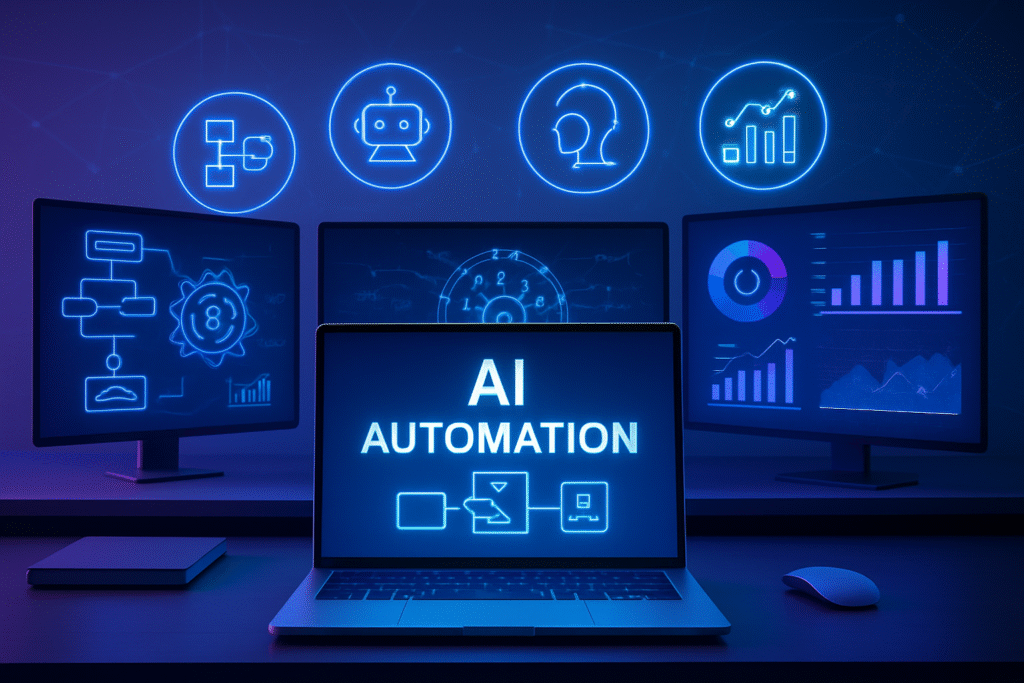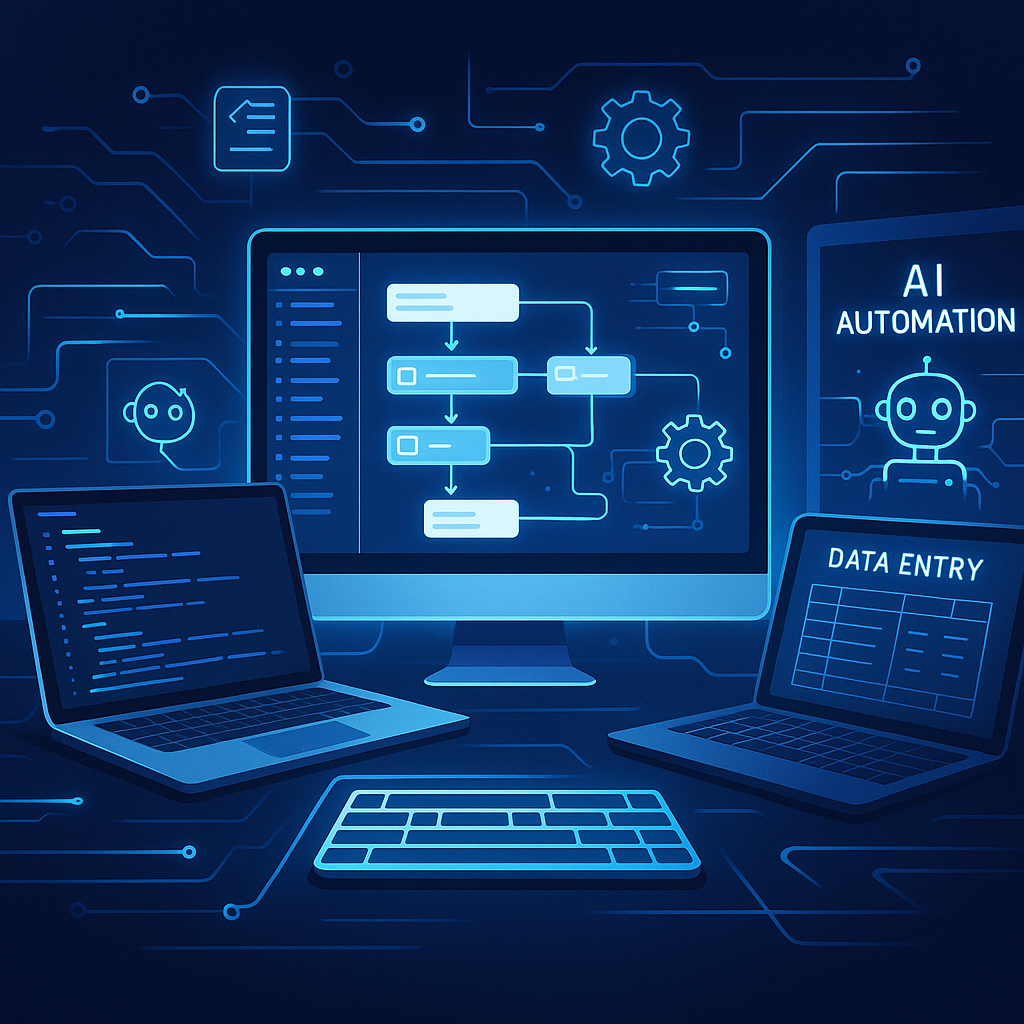1. Introduction
When most people hear about artificial intelligence, they imagine smart algorithms, machine learning models, and endless lines of code. But there’s a part of AI that often gets overlooked — networking. In reality, networking concepts for AI automation beginners are just as important as the code behind the intelligence.
Think about it: AI systems don’t live in isolation. Whether it’s a chatbot answering your questions, a smart thermostat adjusting the temperature, or a recommendation engine suggesting your next movie — all these systems depend on networking to send and receive data. They rely on the internet, cloud platforms, and local networks to communicate, process, and automate actions in real time.
This is where AI automation comes in. It’s the use of AI to complete tasks automatically, often without human input. But for automation to work smoothly, the different parts of a system need to talk to each other — and that’s where networking fundamentals matter.
In this post, we’ll break down the most important networking concepts that every AI automation beginner should understand. You don’t need a computer science degree — just curiosity. By the end, you’ll know why networks matter in AI, how data moves, and what tools can help you get started. Let’s keep it simple, practical, and powerful.
2. Why Networking Matters in AI Automation
To understand how AI works in real life, you need to understand how it moves data. And that’s where networking steps in. Without a solid network, AI systems can’t talk to other devices, share information, or respond in real time. For AI automation to work, data must flow smoothly — from sensors to servers, and back again.
Take smart assistants like Alexa or Google Assistant. When you ask a question, your voice goes to a cloud server. That server processes the input, finds the answer, and sends it back to your device — all in seconds. What makes this possible? A network. It connects your device to the internet, and the internet to an AI engine.
The same happens with self-driving cars. These vehicles don’t just rely on cameras and sensors. They also send data to centralized systems and receive updates or commands from remote servers. Networking helps the car stay aware of traffic conditions, road changes, and even weather updates — all in real time.
APIs (Application Programming Interfaces) are another example. APIs let different software systems “talk” to each other over a network. In AI automation, APIs are often used to connect machine learning models with apps, websites, and tools that trigger tasks or handle user input.
Without networking, AI would be stuck in a box — smart, but silent. For AI automation beginners, it’s essential to understand that every automated decision, prediction, or action depends on one key thing: data flow, and networking makes that possible.
3. Core Networking Concepts Explained
Before AI automation can run smoothly, your systems need to understand the basics of how data travels. Networking might sound technical, but once you see it in action, it’s like watching a well-organized delivery system.
What is a Network?
A network is simply a group of devices that can talk to each other. These devices could be your computer, smartphone, smart TV, or even a self-driving car. Networking connects them so they can send, receive, and process data — the lifeblood of AI automation.
Think of it like a postal system. You write a letter, drop it in a mailbox, and it gets delivered to your friend. Similarly, your AI system sends data across the network to reach the right destination.
IP Addresses
Just like every house has a street address, every device on a network has an IP address — a unique number that tells other devices where to send information. Without an IP address, your AI system wouldn’t know where to deliver the data.
DNS – The Internet’s Phonebook
Remembering numbers is hard. That’s why we use names like google.com instead of 142.250.64.78. The Domain Name System (DNS) works like a phonebook. It matches human-friendly names to IP addresses. So, when your AI tool wants to connect to a cloud service, DNS helps it find the right server instantly.
Protocols (TCP/IP, HTTP)
Protocols are sets of rules that devices follow to talk to each other. For AI automation, the most important ones are:
- TCP/IP – Like a delivery service that checks every package is delivered correctly, Transmission Control Protocol/Internet Protocol ensures data arrives safely and in order.
- HTTP – The Hypertext Transfer Protocol is how web pages (and many AI apps) request and share data over the internet.
Without protocols, communication would be like two people speaking different languages — no understanding, no results.
Client-Server Model
Most networks use the client-server model. A client (your app or device) makes a request, and a server (usually in the cloud) sends back data. AI automation tools often use this model — your chatbot sends a question, the server sends an answer.
Bandwidth & Latency
Two more important terms:
- Bandwidth = How much data you can send at once (like the width of a road).
- Latency = How fast the data arrives (like how long it takes your pizza to get delivered).
Lower latency and higher bandwidth mean your AI tools can respond faster and work better.
4. How AI Systems Use Networking in Real Life
AI automation doesn’t work in isolation. Behind every smart assistant, chatbot, or self-driving car, there’s a powerful network making everything tick. Let’s break down how networking powers real-world AI systems — from your home to the cloud.
Cloud-Based AI Services
Most AI tools you use daily don’t run entirely on your phone or laptop. Instead, they rely on cloud-based AI services. Think of the cloud as a giant remote brain. When you ask ChatGPT a question or use Google Translate, your request travels through the internet to powerful cloud servers. These servers process the data using advanced AI models — then send the answer back.
Without fast, reliable networking, cloud-based AI would feel like dial-up internet in 2025 — frustratingly slow.
API Communication: The Middleman of AI
APIs (Application Programming Interfaces) act like messengers between apps. Let’s say your AI task automation tool needs weather data to make decisions — it can’t magically guess it. Instead, it calls a weather API, which sends back real-time data.
This back-and-forth — data going out, results coming in — is all made possible by networking. APIs are essential for building flexible, modular AI workflows that automate tasks across platforms.
IoT + AI = Smart Homes, Smart Decisions
Now imagine your smart thermostat learns your preferences. It senses when you’re home (thanks to IoT devices like sensors) and adjusts the temperature automatically. That’s AI automation using networking in real time.
Each device — sensors, lights, voice assistants — connects through a network to share data and make smart decisions together.
Centralized vs. Decentralized AI Networks
In centralized systems, data flows to a central server (like the cloud) for processing. It’s efficient but may raise privacy concerns.
Decentralized networks, like on-device AI or blockchain-powered tools, process data locally or across many nodes — reducing risk and speeding up decisions.
Both models rely on robust networking. The choice depends on the task: real-time automation? Decentralized may win. Massive processing? Centralized cloud power is better.

5. Why Beginners Often Overlook Networking (and Why You Shouldn’t)
If you’re new to AI automation, it’s easy to think it’s all about feeding data into models and watching the magic happen. But here’s the thing — AI doesn’t live in a vacuum. It needs a reliable highway to move that data around, and that’s where networking comes in.
The Myth: “AI = Data + Models Only”
Many beginners focus only on the visible parts of AI — datasets, machine learning, prompts, or automation tools. But understanding networking gives you a system-level view, revealing how all the parts actually work together behind the scenes.
Imagine building a smart home app that controls lights, fans, and thermostats — but forgetting how these devices talk to each other. Without a solid grasp of networking, your AI can’t connect, update, or automate properly.
Why It Matters
Here’s what happens when you do understand networking:
- Better Performance: Knowing how to reduce latency or avoid bottlenecks makes your automation faster.
- Seamless Integration: You’ll connect APIs, cloud services, and devices without painful trial-and-error.
- Improved Security: Data moves across networks. Understanding the risks helps you protect it.
AI automation is only as smart as the system it runs on — and networking is that system’s backbone.
So before you chase the next shiny tool, make sure your digital plumbing is solid. Your AI will thank you.
6. Simple Networking Tools and Resources for AI Learners
Learning networking doesn’t mean drowning in complex server rooms or memorizing tech jargon. Today, there are beginner-friendly tools and resources that make it surprisingly easy — even if you’re just starting out in AI automation.
Handy Tools to Get Comfortable With
- Wireshark: Think of this as a microscope for network traffic. It shows you how data flows between devices, perfect for spotting patterns or debugging.
- Ping & Traceroute: These basic commands help you test if a device is reachable and trace the path your data takes. Great for understanding latency and connection issues.
- Postman: If you’re working with APIs (which many AI tools do), Postman lets you test, send, and receive data easily — no coding needed.
Beginner-Friendly Learning Platforms
- Cisco Packet Tracer: A visual simulator where you can build and test virtual networks without needing real hardware. It’s used in Cisco’s networking courses but is also free for learners.
- Coursera Networking Basics: Offers step-by-step courses from top universities that cover core networking concepts for beginners — no prior experience required.
YouTube Channels Worth Following
- NetworkChuck: Breaks down networking concepts in a fun and visual way.
- Jeremy’s IT Lab: Great for absolute beginners who want a slow, structured intro to how networks work.
Start small, stay curious, and try these tools hands-on. The more comfortable you are with networking, the smoother your journey into AI automation will be.
7. Best Practices for Learning Networking Alongside AI
You don’t need to master everything about networking before diving into AI. In fact, the best way to learn is by doing small, real-world projects that blend both AI and networking.
Start with Small Automation Projects
Pick a simple task—like sending an automatic email when a new row is added to a Google Sheet. Use platforms like Zapier or Make.com to connect services through APIs. This teaches you how data moves between tools without needing to write complex code.
Combine Python + Networking
Python is the go-to language for AI, and it’s also great for learning networking. Try using Python to call an API (like OpenWeather or ChatGPT), retrieve data, and display it in a simple script. This builds a solid foundation in both AI automation and networking basics.
Practice Real Service Integration
Experiment with connecting tools like Google Sheets, Notion, or Slack to AI APIs. These projects help you understand client-server communication, API requests, and how cloud-based services talk to each other.
Join Online Communities
Networking isn’t just for computers! Join forums like Reddit’s r/learnprogramming, explore GitHub for open-source AI projects, or contribute to beginner-friendly tools. You’ll learn faster by asking questions, getting feedback, and seeing how others build their systems.
Bottom line: Don’t separate AI and networking—learn them together. When you combine them in small, practical ways, you’ll not only become a better AI builder, but also a smarter problem solver.
8. Conclusion: Networking Is the Secret Skill Every AI Beginner Needs
As you begin your journey into the world of AI automation, one skill often overlooked—but absolutely essential—is networking.
From understanding how APIs connect services, to seeing how AI systems rely on cloud-based data transfer, networking concepts power much of what AI does behind the scenes. It’s not just about cables and routers—networking is the invisible thread that helps your automations talk, share, and act in real time.
By learning basic networking skills alongside AI, you’ll unlock smarter automations, more secure workflows, and better performance overall.
Here’s the key takeaway: AI isn’t just about models and data—it’s about how those elements interact across systems. And networking is how that interaction happens.
If you found this helpful, leave a comment, or bookmark this blog—your future AI self will thank you!
9. Frequently Asked Questions (FAQs)
1. Do I need to learn networking to start with AI automation?
Not deeply—but yes, a basic understanding of networking helps a lot. If you know how systems communicate (like using APIs or understanding IP addresses), you can build more reliable, connected AI tools faster.
2. What’s the easiest way to learn networking as a beginner in AI?
Start with real-life tools like Ping or Postman, then watch beginner-friendly tutorials on YouTube. You don’t need a computer science degree—just curiosity and hands-on practice.
3. What is the role of APIs in AI networking?
APIs act like messengers between apps and systems. In AI automation, they allow tools to share data—like sending a customer email from Google Sheets using an automation bot.
4. Is networking only for IT professionals?
Nope! Even non-techies benefit from learning simple networking basics for AI. Whether you’re a freelancer or hobbyist, understanding how devices and apps “talk” helps you automate smarter.
5. What networking tools should AI learners start with?
Try beginner-friendly tools like Wireshark, Traceroute, Postman, or explore Cisco Packet Tracer. These tools teach you the flow of data and how systems connect in real-world AI setups.
6. How does cloud networking affect AI performance?
AI tools often run in the cloud. Faster, reliable networks mean quicker response times, smoother data flow, and better performance for your AI-powered automations.
Also read:
Essential Skills You Need to Master Before Building AI Workflows



